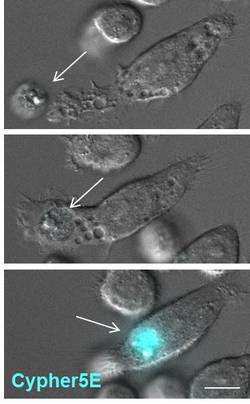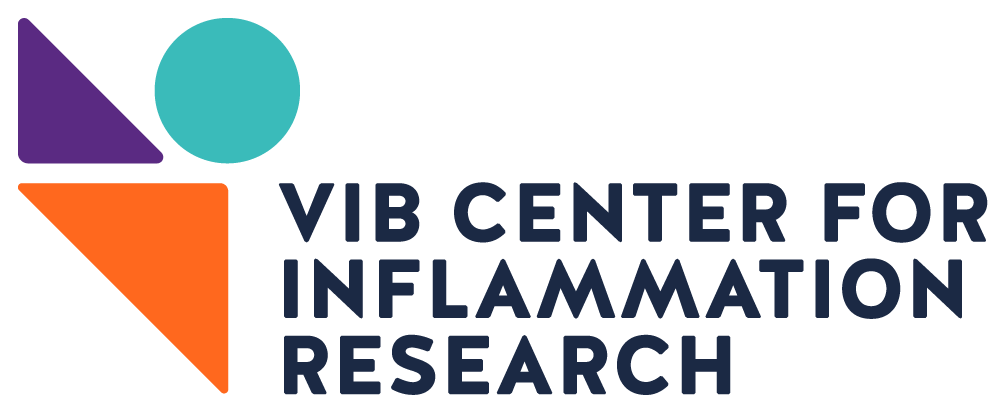
Apoptotic cell clearance mechanisms in health and disease
Engulfment of apoptotic cells - the art of eating a good meal. Every day, we turn over billions of cells as part of normal development and homeostasis. Failure to promptly and efficiently clear apoptotic cells can lead to chronic inflammation, autoimmunity and developmental defects. The cell clearance is usually done by neighboring cells or by professional phagocytes such as macrophages and dendritic cells. We study four broad issues related to 'eating an apoptotic meal'.
The first issue is getting to the meal itself. This involves the release of so called 'find-me signals' from apoptotic cells that serve to recruit nearby phagocytes. We have identified a critical role for the nucleotides ATP and UTP as find-me signals released very early on during apoptosis, via plasma membrane pannexin channels (Elliott et al. Nature, 2009; Chekeni et al., Nature, 2010; Poon et al., Nature 2014).
The second issue is determining what is on the menu, and distinguishing the apoptotic cell from the neighboring healthy cells. This is achieved through expression of 'eat-me' signals on apoptotic cells and their recognition by receptors on phagocytes. Here, we focus on the ligands on the dying cell and receptors on phagocytes that are involved in the specific recognition of apoptotic cells. Our work has identified the engulfment receptor (BAI1) that recognizes phosphatidylserine, a key eat-me signal exposed on apoptotic cells (Park et al. Nature 2007, Park et al. Current Biology, 2009; Hochreiter-Hufford et al., Nature 2013).
The third issue is the act of eating the meal itself. Here, we focus on intracellular signals initiated within the phagocyte when it comes in contact with apoptotic cells, and how this leads to cytoskeletal rearrangements for target uptake and anti-inflammatory signaling. We have defined the signaling pathway downstream of BAI1 involving the proteins ELMO1, Dock180 and the small GTPase Rac (Gumienny et al. Cell , 2001; Brugnera et al. Nature Cell Biology, 2002; Lu et al. Nature Str Mol. Biol. , 2004; deBakker et al. Currently Biology, 2004; Lu et al. Current Biology, 2005; Ravichandran, Cell, 2003). We have also generated mice with knockout of specific engulfment genes and are currently characterizing them (Elliott et al., Nature, 2010).
The fourth issue relates to 'after-the-meal' issues. Contrary to other types of phagocytosis (such as bacterial uptake), engulfment of apoptotic cells is actively ‘anti-inflammatory’. We address how apoptotic cells induce an anti-inflammatory state of the phagocyte, and how this relates to suppression of inflammation (Juncadella et al., Nature, 2013; Lee et al., Immunity, 2016; Han et al., Nature, 2016). Also, when one cell eats another, the phagocyte essentially doubles its cellular contents (including protein, lipids, nucleotides, etc.). We are addressing how the ingested cargo is processed within the phagocyte, and how the phagocyte manages homeostasis (Kinchen et al. Nature Cell Biology, 2008; Kiss et al. Current Biology, 2007; Kinchen et al, Nature 2010; Fond et al., JCI, 2015), and what controls an appetite of the phagocyte in ingesting multiple apoptotic cells (Park et al., Nature, 2011).
We use a combination of molecular biology, cell biology, biochemistry, coupled with mouse knockout studies to gain insights on how specific proteins orchestrate the intracellular signaling and the immunologically silent clearance of apoptotic cells. These could have implications for future therapies aimed at limiting inflammation (Elliott et al., JCB, 2010, Developmental Cell, 2016).
Areas of Expertise
- Mechanisms of apoptotic cell clearance - genes, molecules, and pathways
- Mouse models of human diseases influenced by impaired cell clearance
- Drug discovery and targeting of specific engulfment pathways
Technology Transfer Potential
- Drugs targeting the engulfment machinery to boost cell clearance in vivo
- Drugs targeting the pannexin channels to regulate hypertension as well as inflammation
- Drugs targeting the engulfment module for arthritis and bone erosion
Selected publications
- Etchegaray, J. I. et al. Phagocytosis in the retina promotes local insulin production in the eye. Nat Metab 5, 207-218 (2023). Visit ➚
- Morioka, S. et al. Chimeric efferocytic receptors improve apoptotic cell clearance and alleviate inflammation. Cell 185, 4887-4903 (2022). Visit ➚
- Raymond, M. H. et al. Live cell tracking of macrophage efferocytosis during Drosophila embryo development in vivo. Science 375, 1182-1187 (2022). Visit ➚
- Maschalidi, S. et al. Targeting SLC7A11 improves efferocytosis by dendritic cells and wound healing in diabetes. Nature 606, 776–784 (2022). Visit ➚
- Anderson, C. J. et al. Microbes exploit death-induced nutrient release by gut epithelial cells. Nature 596, 262-267 (2021). Visit ➚
Bibliography
- Full bibliography Visit ➚

Image of a phagocyte engulfing an apoptotic cell. Here the phagocyte is unlabeled but the apoptotic cell is labeled with a dye Cypher5E that has low basal fluorescence but in the acidic pH of the lysosomes (within the phagocyte), fluoresces brighter. This provides a convenient way to track engulfed apoptotic cells. To view a movie of a phagocyte engulfing an apoptotic cell, click on the external link below.
External links
- Movie of a phagocyte engulfing an apoptotic cell. Visit ➚
